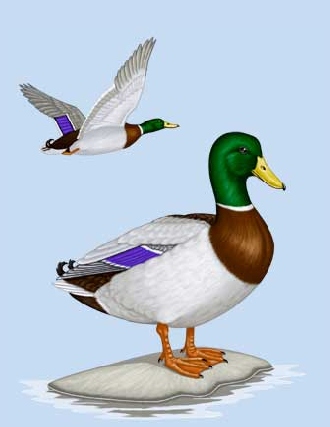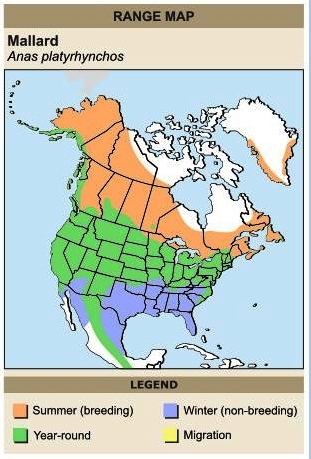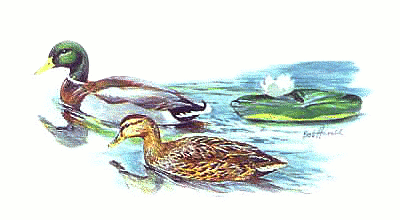|

Medium-sized
dabbling duck with gray body and chestnut-brown breast. The head is
green and neck ring is white.
Bill
is yellow-green. Wing speculum is white-bordered metallic purple-blue.
The tail is dark with distinct white edges and two curled black feathers.
Legs and feet are orange.
The male Mallard has a gray body and chestnut-brown breast, green
head, and white neck ring. The tail is black with distinct white edges
and two curled black feathers.

|
MALLARD
Anas platyrhynchos
ANSERIFORMES
Geese and Ducks (Anatidae)
Range and Habitat
Breeds from Alaska and Quebec south to southern California, Virginia,
Texas, and northern Mexico. Spends winters throughout the U.S. and south
to Central America and the West Indies. Preferred habitats include ponds,
lakes, marshes, small river bends, bays, ditches, and city ponds.

SOUND: "kwek-kwek-kwek"
The Mallard is the ancestor of all domestic duck breeds, except the
Muscovy Duck. Mallards are the most abundant and widespread of all waterfowl;
every year millions are harvested by hunters with little effect on their
numbers.
The greatest threat to mallards is loss of habitat, but they readily
adapt to human disturbances.
They frequently breed with domestic ducks, producing a large variety
of patterns and colors. They also hybridize with wild species such as
the closely related American Black Duck and even occasionally with Northern
Pintails .
A group of mallards has many collective nouns, including a "battling",
"daggle", "doppling", "lute", and "sword"
of mallards.
The Mallard has a large range, estimated globally at 10,000,000 kilometers.
Native to the Americas, Europe, Asia, and Africa, and introduced to
Australia and New Zealand, this bird prefers wetland ecosystems, though
it can live in ponds and other artificial aquatic environments. The
global population of this bird is estimated at 29,000,000 to 30,000,000
individuals.

|